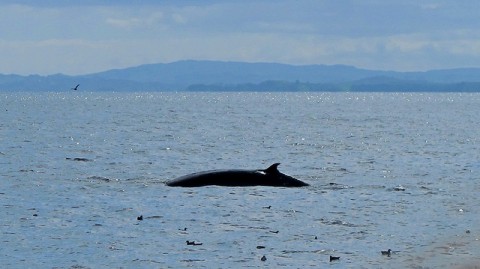Fixing the gulf
Blogger: Forest & Bird’s Marine Advocate Karen Baird
Auckland city is a watery one by most standards – so it seems fitting, if not a little ambitious to give its 1.4 million citizens a watery playground of national park status.

Auckland's resident whale - the Bryde's whale. Boat strike has been a problem for these whales. It is hoped that the Hauraki Gulf Marine Park forum can enforce slower boat speeds to prevent these unwanted deaths.
For 11 years councillors and bureaucrats have trumpeted the formation of the Hauraki Gulf Marine Park, however, since its formation very little has been done to improve our marine life.
Once the harbour used to bristle with vast beds of mussels, kelp-covered reefs and scores of whales.
Indeed, Whangaparoa, in Rodney, translates as the ‘bay of whales’ – imagine that, a harbour full of leviathans. No more.
Every three years, the forum has commissioned a State of Environment report on the health of the harbour which is mulled over by red-faced officials.
And well, this year is no different. Lets just say they won’t be bringing out the trumpet on its public unveiling on August 9 but rather a more doleful instrument to accompany the report’s findings – perhaps an organ?
One of the problems with the forum it is essentially a toothless tiger – although it is filled with officials from local & regional councils, Ministry of Fisheries and DOC, they can only make recommendations to their various constituent bodies.
Rather than setting tickable goals, the forum was given the task to “monitor,” “facilitate” and “encourage”.
Perhaps one of the only inadvertent triumphs of the forum has been the enhancement of several protected islands where predator eradications (Hauturu- Little Barrier Island, Rangitoto, Motutapu) have bolstered native species populations.
For the most part though, the recent meeting and report mapped out an area whose marine life is still under threat. Here’s a snapshot of what is, and isn’t protected and how we can start to reverse this trend.
• Just 0.3% of the gulf is in marine reserves (Leigh marine reserve, Tawaharanui, Pollen island, Long Bay – North shore, Waiheke). Although we have five marine reserves, they’re all miniscule. The forum could advocate for a network of marine reserves, including the one mooted around Great Barrier Island.
• It is home to 410,000 cows – the bovine population seems to be growing in South Waikato, and diminishing elsewhere (Rodney, Franklin and Manukau). Their effluent is raising nutrient levels in Firth of Thames to unprecedented levels – an increase of 1% in nitrogen levels a year. Setting limits and standards is essential to improve water quality.
• Dredging has chewed through the mussel beds, which has had a knock-on effect on the fish populations. Still, fishers are allowed to trawl, dredge and long-line in the gulf. Initial reports suggest that long-lining of snapper is directly resulting in the decline of our endemic black-faced petrels.
• Lobster stocks are depleted and not rebuilding. Reducing the Total Allowable Catch of snapper will enable kina barrens to recover and provide much needed habitat for rock lobsters.
• The only known remnant population of whales – Brydes whales are highly threatened. Eleven have been killed by ship strike and two by entanglement in mussel lines in the past decade. Speed restrictions need to be placed on ships. Currently, a study is being undertaken to determine the feeding preferences of these whales, which may feed back to fishing restrictions.
Of particular interest will be how the Minister of Fisheries responds to calls by environmental commentators such as Dr Roger Grace to restore fish stocks to between 40 – 50% of their original levels.
At present 23% is considered to be a sustainable yield level i.e what keeps the fish replenished but not restored.
Snapper are the only fish that are tough enough to eat kina, so if restrictions are placed on their catch, kina will no longer reign and eventually the sea-bed will return to kelp covered reefs which will support a diversity of marine life.
Of course, we can’t just look at the marine environment – we need to look at what we’re doing on land.
Humans bring with them a range of problems – de-nuding the landscape creates sedimentation which eventually silts up our waterways and eventually clogs up the Hauraki Gulf .
Having a plan that takes account of these land –to-sea processes is essential, and anyone with an interest in our marine habitat should carefully examine Auckland’s Spatial plan.
Indeed, it is easy to criticise such lofty plans – implementing them is the trick. By getting the public to come on board as critical observers of the spatial plan and marine park, we can rile up our local body politicians and fisheries officials and keep them on track, and on the job.
